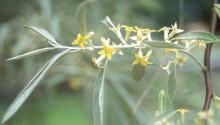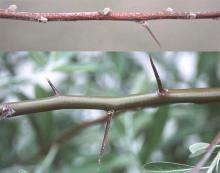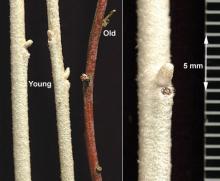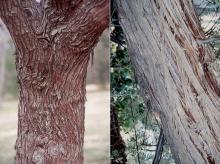Elaeagnus angustifolia
Common name:
Russian-olive
Pronunciation:
e-lee-AG-nus an-gus-ti-FO-li-a
Family:
Elaeagnaceae
Genus:
Type:
Broadleaf
Native to (or naturalized in) Oregon:
Yes
- Deciduous shrub/tree, 15-20(40)ft [4.5-6(12) m] rounded outline, young branches silvery, stems sometimes thorny. Leaves alternate, simple, oblong to linear-laceaolate (willow-like), 2.5-7.5 cm long and 1-1.5 cm wide, margin entire, dull green above and silvery below. Flowers small, 1 cm long, perfect, silvery on the outside, yellow inside, calyx tube campanulate. Fruit drupe-like, 15 mm long, yellow with silvery scales.
- Sun, drought and cold resistant, prefers alkaline soils, few pests.
- Hardy to USDA Zone 2 Native to southern Europe and western and central Asia. However, it is now widely distributed in North America and has become naturalized in many areas, including eastern Oregon (see below).
- Caution: listed as a noxious weed by the U. S. federal government and many states. Apparently brought to North America in the late 1800s; it was planted as an ornamental, and subsequently escaped into the wild. Until recently, the U.S. Soil Conservation Service recommended Russian-olive for wildlife planting and windbreaks. The small fruit is readily eaten and disseminated by many species of birds. It out competes native vegetation, interferes with natural plant succession and nutrient cycling, and taxes water reserves. Because it is capable of fixing nitrogen in its roots, it can grow on bare, mineral substrates and dominate riparian vegetation where overstory cottonwoods have died. Russian-olive is found along streams, fields and open areas. (Plant Conservation Alliance, Alien Plant Working Group, www.nps.gov/plants/alien/fact/elan1.htm).
- Elaeagnus: a Greek name originally applied to a willow, from helodes, growing in marshes, and hagnos, pure, referring to the white fruit masses of the willow. angustifolia: narrow leaved










